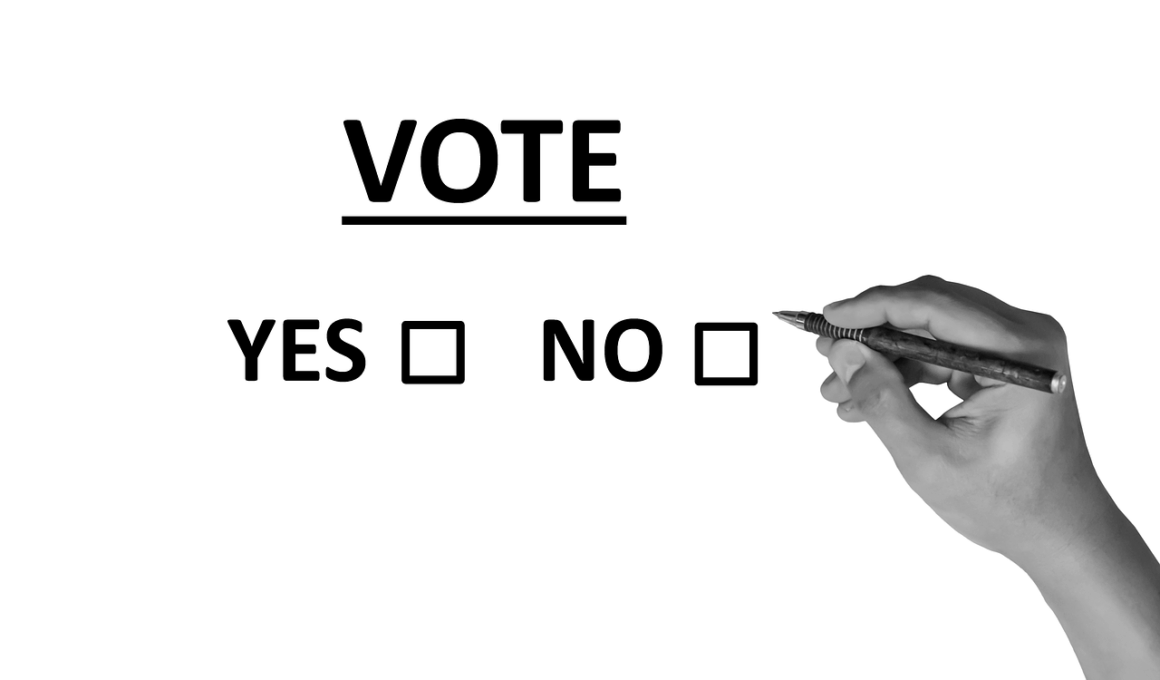The Psychology Behind Poll Participation and User Engagement
User engagement plays an essential role in the digital landscape today. Understanding the psychological principles behind why users participate in polls can significantly enhance the effectiveness of these tools. One relating factor is curiosity, as users often wish to see how their opinions compare. They are motivated to participate when presented with engaging, relevant topics that resonate with their experiences. Additionally, the feeling of contributing to a collective understanding fosters engagement. Polls can be an effective way to include users in the decision-making process. This participatory aspect allows users to feel valued and recognized. Moreover, social validation is a powerful psychological motivator; when users see others engaging, they feel encouraged to join in. Each response contributes to a more comprehensive picture of user sentiment, which in turn fosters further exploration of survey results. This creates a cycle of continuous engagement, enhancing brand loyalty. By applying these psychological insights, marketers can design polls that not only solicit opinions but also deepen user connections. Triggering curiosity and validating social participation becomes pivotal to successful user engagement strategies.
Conducting surveys effectively involves a variety of strategies, which bring to light the deeper motivations driving user participation. One notable technique is crafting questions that invoke emotions, which helps in eliciting honest responses. When participants feel emotionally connected to the questions, they are more likely to engage and complete the survey. Additionally, providing clear instructions can enhance user experience and satisfaction, ensuring users understand the purpose. Polls should also be concise and focused, respecting participants’ time. When users perceive that their time is valued, they are more inclined to contribute. Gamification elements can also be beneficial, making the process enjoyable while improving completion rates. Users may be encouraged to participate in polls that have visual progress indicators or rewards upon completion. Furthermore, sharing insightful results after participation can provide users a sense of reciprocity, rewarding their engagement by making them aware that their contributions matter. In the digital age, fostering a culture of active participation in surveys ensures not only higher completion rates but also enriched data quality, leading to more effective decision-making for businesses.
Engagement through Incentives
Offering incentives is another effective technique to boost user participation in polls. Incentives can take various forms, such as monetary rewards, discounts, or entries into contests, aligning users’ willingness to engage with tangible benefits. Surveys that incorporate such rewards often experience considerably higher response rates. Users appreciate being acknowledged for their time and opinions, and offering incentives can transform passive observers into active participants. Moreover, the type of incentive can significantly impact engagement levels. For instance, offering exclusive access to content or future products can create excitement among users. This anticipation encourages users to provide their input, eager to receive the reward. However, it’s essential to ensure that the incentives align with the target audience’s interests. Poorly chosen incentives may fail to attract participants and could even damage brand perception. Understanding the demographics and preferences of the audience is crucial in designing effective incentives. Additionally, promoting the incentives through various channels allows brands to reach a broader audience, maximizing participation while enhancing user engagement. Ultimately, well-implemented incentives can create win-win situations, benefiting both users and brands alike.
Enhancing user engagement through effective communication strategies can drastically influence poll participation. Clear communication about the purpose and importance of polls encourages users to contribute meaningfully. Transparency is key; participants appreciate knowing how their responses will be used and how they contribute to larger objectives. Emails, notifications, or social media posts that outline these details can motivate users to take part. Engaging narratives also play a critical role in forming user connections. When polls introduce relatable stories or challenges, they evoke empathy, increasing the likelihood of participation. Providing context helps users feel more invested in the outcome of the poll. Moreover, personalization touches, such as addressing users by name or customizing questions, can help in demystifying the process and creating a sense of individual importance. By making users feel like integral parts of the conversation, their willingness to engage rises. Furthermore, maintaining open channels for user feedback fosters trust, solidifying relationships beyond just one-off interactions. Clear communication and storytelling can transform the user experience, enhancing ongoing participation in future polls and surveys.
Utilizing Technology in Polls
Technology plays a significant role in user engagement, especially when it comes to the execution of polls and surveys. Many platforms leverage advanced analytics that track user behavior, enabling them to refine poll strategies effectively. For instance, real-time feedback and adaptive questioning can ensure that polls remain relevant and engaging. Users are more likely to share their opinions when they see that their input leads to changes or adjustments in questions based on responses. Additionally, mobile-friendly designs enhance accessibility, allowing users to participate from anywhere, boosting response rates. The integration of artificial intelligence can also create personalized experiences, catering to individual users’ preferences and behaviors. This could involve customizing polls based on past interactions to improve relevance and engagement significantly. Furthermore, utilizing social media integration enables users to easily share their poll responses with their networks, creating a snowball effect that encourages wider participation. Technology, when used effectively, streamlines the feedback process and makes it more enjoyable, thus increasing the likelihood of user engagement and fostering long-term relationships with audiences.
Analyzing the results stemming from user participation in polls is crucial to uncovering actionable insights. Proper analysis empowers brands to gauge user sentiments accurately and adjust strategies accordingly. By examining trends and patterns in responses, businesses can identify areas for improvement and better align their offerings with user needs. Both quantitative and qualitative analysis can offer deep perspectives; numbers tell one story, while the narratives behind them reveal others. Additionally, leveraging data visualization tools can enhance the presentation of results, making findings more digestible for stakeholders and users alike. Users appreciate transparency, so sharing results can create a sense of community and reinforce their involvement. Engaging users in the interpretation of results invites further participation, as they feel their contributions matter and lead to substantial outcomes. Furthermore, presenting these insights through various formats, such as infographics, engaging reports, or videos, can cater to diverse audiences and increase the likelihood of information dissemination. By outlining key findings and providing clear recommendations based on survey responses, brands strengthen their credibility and foster deeper relationships with users.
Long-term User Relationships
Building long-term relationships with users through ongoing engagement is crucial for sustained interaction. Polls should not be viewed as standalone events. Integrating them into a broader engagement strategy keeps users revisiting and participating consistently. Frequent communication, whether through newsletters or updates, ensures that users remain informed and engaged with brand activities. Additionally, creating a community around polling themes can turn users into advocates, promoting polls within their networks. This often leads to organic growth, where users feel compelled to contribute based on their relationships with existing community members. Furthermore, loyalty programs that acknowledge repeat participation foster a sense of belonging among users. By ensuring that users feel valued through recognition and rewards, businesses solidify long-term relationships that transcend transactional interactions. This investment in relationship-building becomes vital in a landscape where user preferences continually evolve. Building such rapports on a foundation of trust enhances users’ willingness to engage with future polls. Ultimately, a strategic focus on user relationships amplifies brand loyalty and promotes dynamic ongoing user engagement, benefiting both users and brands significantly.
In conclusion, applying psychological insights and effective engagement techniques can significantly enhance user participation in polls. This multi-faceted approach addresses incentives, communication methods, and technology use, which are all interconnected aspects that shape user engagement strategies. By refining these elements, brands can constantly adapt to the changing preferences of their audiences, ensuring higher responsiveness and valuable data collection in the process. The advantage lies in recognizing the power of participation, curiosity, and emotional connection in driving responses. Polls that resonate with users’ feelings and experiences, while providing rewards and utilizing technology effectively, create a dynamic engagement loop. This not only empowers users but also enables brands to make informed decisions based on collective feedback. As engagement continues to take center stage in digital interactions, the successful implementation of these strategies will distinguish brands in crowded marketplaces. Ultimately, effective poll participation becomes a two-way street—a channel for users and brands to interact, enhance the experience, and create meaningful change. Therefore, embracing these techniques ensures not just participation, but genuine connections that last over time.


